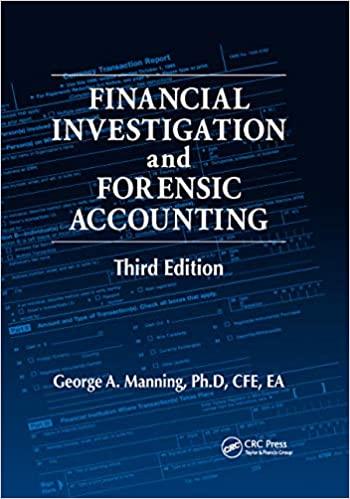Answered step by step
Verified Expert Solution
Question
1 Approved Answer
HelpPlease be more specific. Just 5 and 6. Thank you! Actual Results Static Budget (20,000 PCs) $ 8,100,000 (22,000 PCs) $ $ 9,350,000 1,960,000 2,056,320







HelpPlease be more specific. Just 5 and 6.
Thank you!
Actual Results Static Budget (20,000 PCs) $ 8,100,000 (22,000 PCs) $ $ 9,350,000 1,960,000 2,056,320 Sales (20,000 PCs X $405) (22,000 PCs x $425) Variable manufacturing expenses: Direct materials (200,000 parts x $9.80) (214,200 parts x $9.60) Direct labour (40,000 hrs. x $14.20 ) (42,500 hrs. x $14.80) Variable overhead (200,000 parts x $ 4.00) (214,200 parts x $ 4.10 ) Fixed manufacturing expenses: Fixed overhead 568,000 629,000 800,000 878,220 900,000 930,000 Total cost of goods sold 4,228,000 4,493,540 $ Gross profit 3,872,000 $ 4,856,460 - X Requirements 1. Determine the company's standard cost for one unit. 2. Prepare a flexible budget based on the actual number of PCs sold. 3. Compute the price variance for direct materials and for direct labour. 4. Compute the efficiency variances for direct materials and direct labour. 5. For manufacturing overhead, compute the total variance, the flexible budget variance, and the production volume variance. 6. What is the total flexible budget variance for Eagle System's manufacturing costs? Show how the total flexible budget variance is divided into materials, labour, and overhead variances. 7. Have Eagle System's managers done a good job or a poor job controlling material and labour costs? Why? 8. Describe how Eagle System's managers can benefit from the standard costing system Eagle System assembles PCs and uses flexible budgeting and a standard cost system. Eagle System allocates overhead based on the number of direct materials parts. The company's performance report includes the following selected data: (Click the icon to view the selected data.) Requirements Requirement 1. Determine the company's standard cost for one unit. First, select the formula, then compute the standard cost per unit. (Round your answer to the nearest cent.) Standard total manufacturing costs Standard sales price per unit Standard cost per unit 4228000 1 20000 211.4 Requirement 2. Prepare a flexible budget based on the actual number of PCs sold, Eagle System Flexible Budget for Actual Outputs Sales revenue 8910000 Variable manufacturing expenses: Direct materials 2200000 Direct labour 616000 Variable overhead 880000 Fixed expenses: Fixed overhead 900000 4596000 Total cost of goods sold Gross profit 4314000 Requirement 3. Compute the price variance for direct materials and for direct labour. Begin by determining the formula for the price variance, then compute the price variances for direct materials (DM) and direct labour (DL). (Enter the results as positive numbers. Label each variance as favourable (F) or unfavourable (U).) (Standard price per input unit Actual price per input unit ) x Actual quantity of input Price variance DM 9.80 9.60 ) x 21420 42840 F DL 14.20 14.80 ) x 42500 (25500) U Requirement 4. Compute the efficiency variances for direct materials and direct labour. Begin by determining the formula for the efficiency variance, then compute the efficiency variances for direct materials (DM) and direct labour (DL). (Enter the results as positive numbers. Label each variance as favourable (F) or unfavourable (U).) ( Standard quantity of input Actual quantity of input 1x Standard price per input unit Efficiency variance DM C 220000 214200 ) x 10 58000 F DL ( 44000 42500 ) x 14.2 21300 7 F Requirement 5. For manufacturing overhead, compute the total variance, the flexible budget variance, and the production volume variance. (Enter the results as positive numbers. Label each variance as favourable (F) or unfavourable (U).) Eagle System Manufacturing Overhead Variances Total overhead variance: Actual overhead cost Standard overhead allocated to production Total overhead variance Overhead flexible budget variance: Actual overhead cost Flexible budget overhead for actual outputs Overhead flexible budget variance Production volume variance: Flexible budget overhead for actual outputs Standard overhead allocated to production Production volume variance Requirement 6. What is the total flexible budget variance for Eagle System's manufacturing costs? Show how the total flexible budget variance is divided into materials, labour, and overhead variances. (Enter the results as positive numbers. Label each variance as favourable (F) or unfavourable (U).) Total actual manufacturing costs Total flexible budget manufacturing costs Total flexible budget variance for manufacturing costs Direct material variances: Price Efficiency Total material variances Direct labour variances: Price Efficiency Total direct labour variances Overhead flexible budget variance Total flexible budget variance for manufacturing costs Requirement 7. Have Eagle System's managers done a good job or a poor job controlling material and labour costs? Why? direct materials price variance, direct materials efficiency variance, and direct labour efficiency The variances computed in Requirements 3 and 4 suggest that the managers have done a good job controlling materials and labour costs. The favourable variance far outweigh the unfavourable direct labour price variance. Requirement 8. Describe how Eagle System's managers can benefit from the standard costing system. Select five benefits managers may have from the standard costing system. Standards: Help management control by setting target levels of performance. Help management plan by providing unit amounts for budgeting. Help motivate employees by serving as performance benchmarks. Provide unit costs managers can use to set sales prices. Simplify record keeping and reduce clerical costsStep by Step Solution
There are 3 Steps involved in it
Step: 1

Get Instant Access to Expert-Tailored Solutions
See step-by-step solutions with expert insights and AI powered tools for academic success
Step: 2

Step: 3

Ace Your Homework with AI
Get the answers you need in no time with our AI-driven, step-by-step assistance
Get Started


